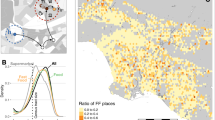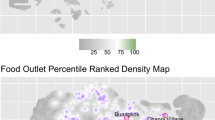Abstract
Recent research on food access has increasingly focused on how individuals’ daily mobility, much of it based on activity spaces created from GPS data. In this paper, we expand this research through an analysis of a large transit survey (n = 21,298 households) from Minneapolis/St. Paul, Minnesota. We do this using relational approach focused on the topological connections found in household travel patterns rather than measures of exposure based on geographic distance. Our exploratory data analysis analyzes both grocery shopping and eating out across the metropolitan area, focusing on the position of utilized food sources relative to home and work locations, utilized modes of transit, and other daily activities often combined with food shopping. Households often used food sources located outside their residential neighborhoods, usually moving toward the central city to do so. Eating out occurred farther from home than grocery shopping, though in many cases close to work. Automobile use was most common for grocery shopping trips, but less so in the lowest income households and in the central city. Our findings show that a relational approach can identify distinctive patterns in everyday food provisioning by emphasizing the connections between food shopping and other everyday household activities.












Similar content being viewed by others
Notes
More information on this study and a downloadable dataset is available at http://www.metrocouncil.org/Transportation/Planning-2/Transit-Plans,-Studies-Reports/Other-Studies-Reports/Travel-Behavior-Inventory.aspx.
References
Anselin, L. (1999). Interactive techniques and exploratory spatial data analysis. In P. Longley, M. Goodchild, D. Maguire & D. Rhind (Eds.), Geographic information systems: Principles, techniques, management and applications (pp. 253–266). New York: Wiley.
Apparicio, P., Cloutier, M.-S., & Shearmur, R. (2007). The case of Montréal’s missing food deserts: Evaluation of accessibility to food supermarkets. International Journal of Health Geographics, 6(4), 1–13. doi:10.1186/1476-072X-6-4.
Black, C., Moon, G., & Baird, J. (2014). Dietary inequalities: what is the evidence for the effect of the neighbourhood food environment? Health and Place, 27, 229–242. doi:10.1016/j.healthplace.2013.09.015.
Boone-Heinonen, J., Gordon-Larsen, P., Kiefe, C. I., Shikany, J. M., Lewis, C. E., & Popkin, B. M. (2011). Fast food restaurants and food stores: longitudinal associations with diet in young to middle-aged adults: The CARDIA study. Archives of Internal Medicine, 171(13), 1162–1170. doi:10.1001/archinternmed.2011.283.
Cannuscio, C. C., Tappe, K., Hillier, A., Buttenheim, A., Karpyn, A., & Glanz, K. (2013). Urban food environments and residents’ shopping behaviors. American Journal of Preventive Medicine, 45(5), 606–614. doi:10.1016/j.amepre.2013.06.021.
Caspi, C. E., Sorensen, G., Subramanian, S. V., & Kawachi, I. (2012). The local food environment and diet: a systematic review. Health and Place, 18(5), 1172–1187. doi:10.1016/j.healthplace.2012.05.006.
Chen, X., & Kwan, M.-P. (2015). Contextual uncertainties, human mobility, and perceived food environment: The uncertain geographic context problem in food access research. American Journal of Public Health. doi:10.2105/AJPH.2015.302792.
Chen, J., Shaw, S.-L., Yu, H., Lu, F., Chai, Y., & Jia, Q. (2011). Exploratory data analysis of activity diary data: A space–time GIS approach. Journal of Transport Geography, 19(3), 394–404. doi:10.1016/j.jtrangeo.2010.11.002.
Christian, W. J. (2012). Using geospatial technologies to explore activity-based retail food environments. Spatial and Spatio-Temporal Epidemiology, 3(4), 287–295. doi:10.1016/j.sste.2012.09.001.
Clifton, K. J. (2004). Mobility strategies and food shopping for low-income families: A case study. Journal of Planning Education and Research, 23(4), 402–413. doi:10.1177/0739456X04264919.
Conradson, D., & Latham, A. (2005). Transnational urbanism: Attending to everyday practices and mobilities. Journal of Ethnic and Migration Studies, 31(2), 227–233. doi:10.1080/1369183042000339891.
Cox, N. J., & Jones, K. (1981). Exploratory data analysis. In N. Wrigley & R. J. Bennett (Eds.), Quantitative geography: A British view (pp. 135–143). London: Routledge and Kegan Paul.
Cresswell, T. (2010). Mobilities I: Catching up. Progress in Human Geography, 35(4), 550–558. doi:10.1177/0309132510383348.
Cummins, S., Curtis, S., Diez-Roux, A. V., & Macintyre, S. (2007). Understanding and representing “place” in health research: A relational approach. Social Science and Medicine, 65(9), 1825–1838. doi:10.1016/j.socscimed.2007.05.036.
Cummins, S., Flint, E., & Matthews, S. A. (2014). New neighborhood grocery store increased awareness of food access but did not alter dietary habits or obesity. Health Affairs, 33(2), 283–291. doi:10.1377/hlthaff.2013.0512.
Dykes, J. (1998). Cartographic visualization: Exploratory spatial data analysis with local indicators of spatial association using Tcl/Tk and cdv. The Statistician, 47(3), 485–497.
Elbel, B., Moran, A., Dixon, L. B., Kiszko, K., Cantor, J., Abrams, C., et al. (2015). Assessment of a government-subsidized supermarket in a high-need area on household food availability and children’s dietary intakes. Public Health Nutrition. doi:10.1017/S1368980015000282.
Fleischhacker, S. E., Evenson, K. R., Rodriguez, D. A., & Ammerman, A. S. (2011). A systematic review of fast food access studies. Obesity Reviews, 12(5), e460–e471. doi:10.1111/j.1467-789X.2010.00715.x.
Forsyth, A., Wall, M., Larson, N., Story, M., & Neumark-Sztainer, D. (2012). Do adolescents who live or go to school near fast-food restaurants eat more frequently from fast-food restaurants? Health and Place, 18(6), 1261–1269. doi:10.1016/j.healthplace.2012.09.005.
Frank, L., Bradley, M., Kavage, S., Chapman, J., & Lawton, T. K. (2007). Urban form, travel time, and cost relationships with tour complexity and mode choice. Transportation, 35(1), 37–54. doi:10.1007/s11116-007-9136-6.
Glanz, K., Sallis, J. F., Saelens, B. E., & Frank, L. D. (2005). Healthy nutrition environments: Concepts and measures. American Journal of Health Promotion, 19(5), 330–333.
Hincks, S., & Wong, C. (2009). The spatial interaction of housing and labour markets: Commuting flow analysis of North West England. Urban Studies, 47(3), 620–649. doi:10.1177/0042098009349777.
Horner, M. W., & Wood, B. S. (2014). Capturing individuals’ food environments using flexible space–time accessibility measures. Applied Geography, 51, 99–107. doi:10.1016/j.apgeog.2014.03.007.
Inagami, S., Cohen, D. A., Brown, A. F., & Asch, S. M. (2009). Body mass index, neighborhood fast food and restaurant concentration, and car ownership. Journal of Urban Health, 86(5), 683–695. doi:10.1007/s11524-009-9379-y.
Jeffery, R. W., Baxter, J., McGuire, M., & Linde, J. (2006). Are fast food restaurants an environmental risk factor for obesity? The International Journal of Behavioral Nutrition and Physical Activity. doi:10.1186/1479-5868-3-2.
Kerr, J., Frank, L., Sallis, J. F., Saelens, B., Glanz, K., & Chapman, J. (2012). Predictors of trips to food desintations. The International Journal of Behavioral Nutrition and Physical Activity, 9(1), 58. doi:10.1186/1479-5868-9-58.
Kestens, Y., Lebel, A., Daniel, M., Thériault, M., & Pampalon, R. (2010). Using experienced activity spaces to measure foodscape exposure. Health and Place, 16(6), 1094–1103. doi:10.1016/j.healthplace.2010.06.016.
Kneebone, E., & Berube, A. (2013). Confronting suburban poverty in America. Washington, DC: Brookings Institution Press.
Kwan, M.-P. (2000). Interactive geovisualization of activity-travel patterns using three-dimensional geographical information systems: a methodological exploration with a large data set. Transportation Research Part C: Emerging Technologies, 8(1–6), 185–203. doi:10.1016/S0968-090X(00)00017-6.
Kwan, M.-P. (2012). The uncertain geographic context problem. Annals of the Association of American Geographers, 102(5), 37–41.
Latham, A. (2003). Urbanity, lifestyle and making sense of the new urban cultural economy: Notes from Auckland, New Zealand. Urban Studies, 40(9), 1699–1724. doi:10.1080/0042098032000106564.
Ledoux, T. F., & Vojnovic, I. (2012). Going outside the neighborhood: The shopping patterns and adaptations of disadvantaged consumers living in the lower eastside neighborhoods of Detroit, Michigan. Health and Place, 19C(1), 1–14. doi:10.1016/j.healthplace.2012.09.010.
Martin, K. S., Ghosh, D., Page, M., Wolff, M., McMinimee, K., & Zhang, M. (2014). What role do local grocery stores play in urban food environments? A case study of Hartford-Connecticut. PLoS One, 9(4), e94033. doi:10.1371/journal.pone.0094033.
Massey, D. (2005). For space. London: Sage.
McQuoid, J., & Dijst, M. (2012). Bringing emotions to time geography: The case of mobilities of poverty. Journal of Transport Geography, 23, 26–34. doi:10.1016/j.jtrangeo.2012.03.019.
Nielsen, T., & Hovgesen, H. (2008). Exploratory mapping of commuter flows in England and Wales. Journal of Transport Geography, 16(2), 90–99. doi:10.1016/j.jtrangeo.2007.04.005.
Raja, S., Yadav, P., & Ma, C. (2008). Beyond food deserts: Measuring and mapping racial disparities in neighborhood food environments. Journal of Planning Education and Research, 27(4), 469–482. doi:10.1177/0739456X08317461.
Rogalsky, J. (2010). The working poor and what GIS reveals about the possibilities of public transit. Journal of Transport Geography, 18(2), 226–237. doi:10.1016/j.jtrangeo.2009.06.008.
Saarloos, D., Kim, J.-E., & Timmermans, H. (2009). The built environment and health: Introducing individual space-time behavior. International Journal of Environmental Research and Public Health, 6(6), 1724–1743. doi:10.3390/ijerph6061724.
Schmöcker, J.-D., Su, F., & Noland, R. B. (2010). An analysis of trip chaining Among older London residents. Transportation, 37(1), 105–123. doi:10.1007/s11116-009-9222-z.
Shannon, J. (2016). Beyond the supermarket solution: Linking food deserts, neighborhood context, and everyday mobility. Annals of the American Association of Geographers, 106(1), 186–202. doi:10.1080/00045608.2015.1095059.
Sheller, M., & Urry, J. (2006). The new mobilities paradigm. Environment and Planning A, 38(2), 207–226. doi:10.1068/a37268.
Smith, N. (2008). Uneven development: Nature, capital, and the production of space (3rd ed.). Athens, GA: University of Georgia Press.
Tana, Kwan, M.-P., & Chai, Y. (2015). Urban form, car ownership and activity space in inner suburbs: A comparison between Beijing (China) and Chicago (United States). Urban Studies. doi:10.1177/0042098015581123.
Tukey, J. W. (1977). Exploratory data analysis. Reading, MA: Addison-Wesley Pub. Co.
United States Census Bureau. (2015). American FactFinder. Retrieved from http://factfinder2.census.gov/.
USDA Economic Research Service. (2009). Access to affordable and nutritious food—Measuring and understanding food deserts and their consequences: Report to congress. Retrieved from http://www.ers.usda.gov/publications/ap/ap036/.
USDA Economic Research Service. (2014). Food Access Research Atlas—Documentation. Retrieved from http://www.ers.usda.gov/data-products/food-access-research-atlas/documentation.aspx#definitions.
Ver Ploeg, M., Mancino, L., Todd, J. E., Clay, D. M., & Scharadin, B. (2015). Where do Americans usually shop for food and how do they travel to get there? Initial findings from the national household food acquisition and purchase survey. Washington, DC: USDA Economic Research Service.
Vojnovic, I., Lee, J., Kotval-K, Z., Podagrosi, A., Varnakovida, P., Ledoux, T., et al. (2012). The burdens of place: A socio-economic and ethnic/racial exploration into urban form, accessibility and travel behaviour in the lansing capital region, Michigan. Journal of Urban Design, 18(1), 1–35. doi:10.1080/13574809.2012.683403.
Widener, M. J., Farber, S., Neutens, T., & Horner, M. W. (2013). Using urban commuting data to calculate a spatiotemporal accessibility measure for food environment studies. Health and Place, 21, 1–9. doi:10.1016/j.healthplace.2013.01.004.
Widener, M. J., & Shannon, J. (2014). When are food deserts? Integrating time into research on food accessibility. Health and Place, 30, 1–3. doi:10.1016/j.healthplace.2014.07.011.
Zenk, S. N., Schulz, A. J., & Israel, B. (2005). Neighborhood racial composition, neighborhood poverty, and the spatial accessibility of supermarkets in metropolitan Detroit. American Journal of Public Health, 95(4), 660–667. doi:10.2105/AJPH.2004.042150.
Zenk, S. N., Schulz, A. J., Matthews, S. A., Odoms-Young, A. M., Wilbur, J., Wegrzyn, L., et al. (2011). Activity space environment and dietary and physical activity behaviors: A pilot study. Health and Place. doi:10.1016/j.healthplace.2011.05.001.
Acknowledgments
The authors wish to thank Debarchana Ghosh, Steven Holloway, and the journal editor and anonymous reviewers for their helpful feedback during the writing and revision of this article.
Author information
Authors and Affiliations
Corresponding author
Ethics declarations
This research is based on a publically available secondary dataset we obtained from a government source, and thus our work involved no direct contact with human subjects or release of sensitive information.
Conflict of interest
We have no conflicts of interest in publishing this research.
Rights and permissions
About this article
Cite this article
Shannon, J., Christian, W.J. What is the relationship between food shopping and daily mobility? A relational approach to analysis of food access. GeoJournal 82, 769–785 (2017). https://doi.org/10.1007/s10708-016-9716-0
Published:
Issue Date:
DOI: https://doi.org/10.1007/s10708-016-9716-0




